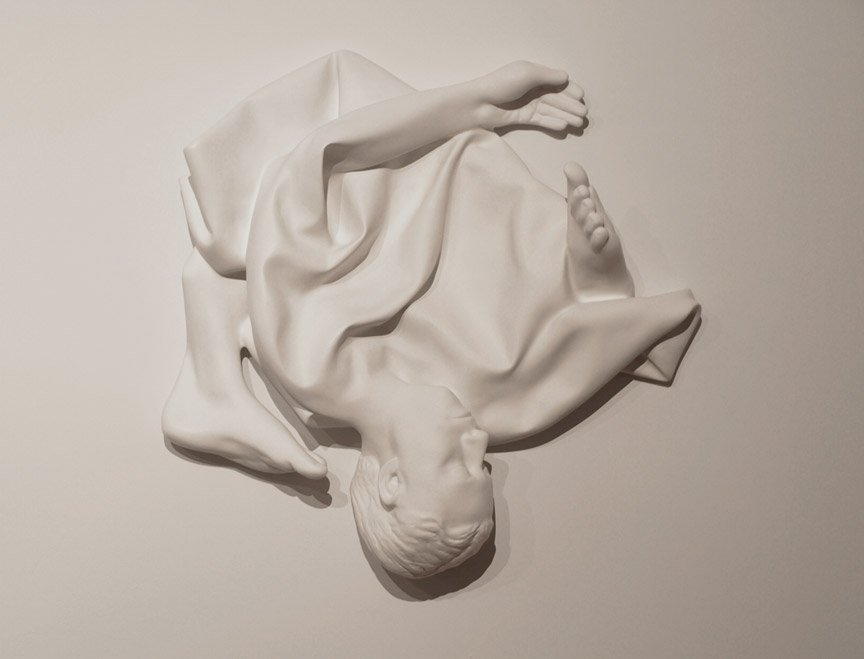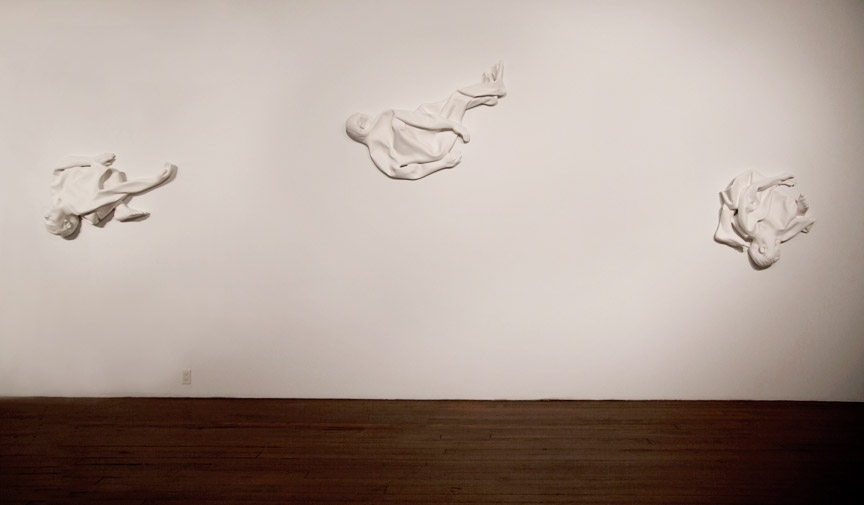Shows
Alwar Balasubramaniam


The rules of time, gravity and scale feel suspended, if only for a moment, in the immersive environment created by Alwar Balasubramaniam (Bala for short) at Talwar Gallery. Upon entering the dim gallery space, one is greeted by four white, drape-like forms hanging on the largest wall, while a barely visible string reaches horizontally toward the adjacent wall. Housed in a smaller back room is an installation of sculptures whose shapes resemble enlarged ears and small asteroids.
In the main gallery space, four fiberglass sculptures, comprising Kaayam (2008), are dispersed horizontally across one wall at different heights. Each sculpture was cast from the artist’s body. However, the intermediary rubber molds produced during the casting process were re-shaped before being used to cast the final pieces in fiberglass. As a result, Kaayam looks as if Bala had taken off his skin, like a piece of clothing, and left it crumpled in flattened masses against the wall. Painted white to match the color of the wall, the four cast-off “skins” appear to be a component of the gallery’s architecture. Though the body is twisted and contorted, the results are not grotesque—the folds of the body evoke those of a delicate fabric, out of which portions of arms, legs and head emerge.
By casting and reshaping the exterior layer of his body, Bala gives more visibility to what is familiar by its distortion, as if to suggest that the body is not so much ours as we may think. In Kaayam, the artist’s body, apart from the artist, takes on a life of its own.

However, if the artist simply wanted to achieve visibility, he would not have camouflaged the sculptures to the wall, thereby simultaneously hiding what was just made manifest. Within this give and take lies the artist’s skepticism of sight. As the press release reads, “seeing is not believing,” negating the commonly accepted phrase, “seeing is believing.” All of Bala’s works maintain this complex relationship with sight and believability.
So what is it that Bala might like his viewers to “see”? The small back room installation, which contains works made this year, helps unravel this question. All the pieces in this room are related to one another. Hold Nothing (2012) and Unfold (2012) are cast from the artist’s clenching hands, while the two stone sculptures, Lines in Fold (2012), get their shape from the negative space that forms between the fingers and palm of a clenched hand. The hands in Hold Nothing are connected by a thin, coiled, tube measuring the artist’s arm span, and face downward so that if anything were held in them, it would fall out. The title seems to command one to “hold nothing,” while the work demonstrates the futility of any attempt to grasp onto something.

Unfold, which resembles an enlarged ear or a seashell, and Lines in Fold, which reminds one of eroded stones or pitted asteroids, are placed on the floor in a casual manner as if brought onto the shore from under the ocean by waves. In comparison to the forms derived from the artist’s body that glide across the main gallery in serene motion, these pieces are bulky. Bala suggests, through this inverse, that for him the invisible impulse to hold onto something is heavier than the visible, physical body. While he is able to take off his skin and surrender it, Unfold and Lines in Fold are almost self-consciously weighted down, testifying to the burdens one keeps hidden within.
Though simple, Bala’s works compel. Their pared-down aesthetic should not cause one to think of the artist as an abstractionist. There is a motive behind Bala’s works, though, with his minimal approach, it is clear the artist does not desire to sermonize. But even this opposition to didacticism is consistent with the artist’s ideology, which is similar to the Buddhist endeavor to overcome the self and the material world, as well as the belief in Buddhism that suffering could be overcome by not holding onto that which affects us. Bala quietly but assertively, implores his viewers to do the same.







